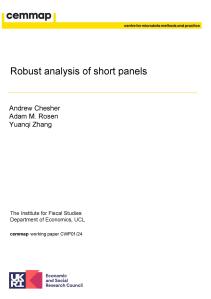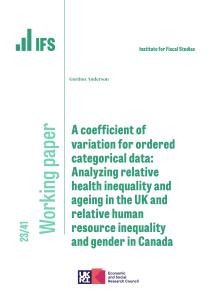This paper studies the relationship between group size and informal risk sharing. It shows that under limited commitment with coalitional deviations, this relationship is theoretically ambiguous. It investigates this question empirically using data on sibship size of household heads and spouses from rural Malawi, exploiting a social norm among the main sample ethnic group to define the potential risk‐sharing group. We uncover evidence of worse risk sharing of crop losses in larger potential risk‐sharing groups, and rule out alternative explanations for the findings. A simple calibration exercise indicates that our empirical findings are consistent with the theory.
Authors

Research Fellow University College London
Emla Fitzsimons is a Professor of Economics at the University College London Institute of Education and a Research Fellow at the IFS.

Research Fellow University College London
Marcos is a Research Fellow at IFS, an Affiliate at the Rural Education Action Program and a Professor of Economics at the University College London.

Research Fellow University of Kent
Bansi is a Research Fellow of the IFS, a Senior Lecturer of Economics at the University of Kent and also a Fellow at the Global Labor Organisation.
Journal article details
- DOI
- 10.1111/ecoj.12565
- Publisher
- Wiley
- Issue
- Volume 128, Issue 612, June 2018, pages F575-F608
Suggested citation
E, Fitzsimons and B, Malde and M, Vera-Hernandez. (2018). 'Group Size and the Efficiency of Informal Risk Sharing' 128(612/2018), pp.F575–F608.
More from IFS
Understand this issue

Gender norms, violence and adolescent girls’ trajectories: Evidence from India
24 October 2022

Empty defence spending promises are a shot in the dark
29 April 2024

Public investment: what you need to know
25 April 2024
Policy analysis

ABC of SV: Limited Information Likelihood Inference in Stochastic Volatility Jump-Diffusion Models
We develop novel methods for estimation and filtering of continuous-time models with stochastic volatility and jumps using so-called Approximate Bayesian Compu- tation which build likelihoods based on limited information.
12 August 2014

Assessing the economic benefits of education: reconciling microeconomic and macroeconomic approaches
This CAYT report discusses the strengths and limitations of several approaches to assessing the effect of education on productivity.
14 March 2013

Misreported schooling, multiple measures and returns to educational qualifications
We provide a number of contributions of policy, practical and methodological interest to the study of the returns to educational qualifications in the presence of misreporting.
1 February 2012
Academic research

Understanding Society: minimising selection biases in data collection using mobile apps
2 February 2024

Robust analysis of short panels
8 January 2024

A coefficient of variation for ordered categorical data: Analyzing relative health inequality and ageing in the UK and relative human resource inequality and gender in Canada
21 December 2023